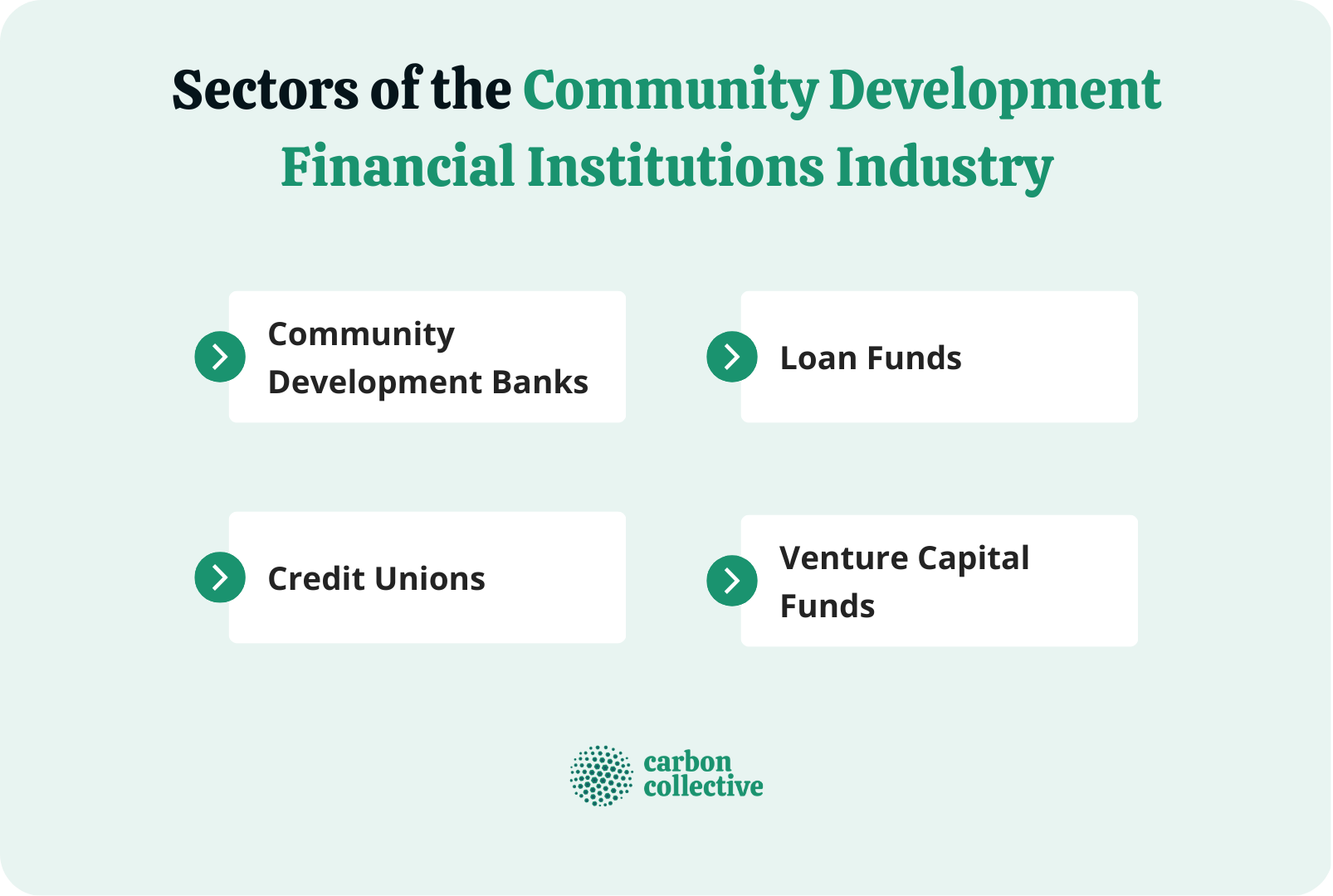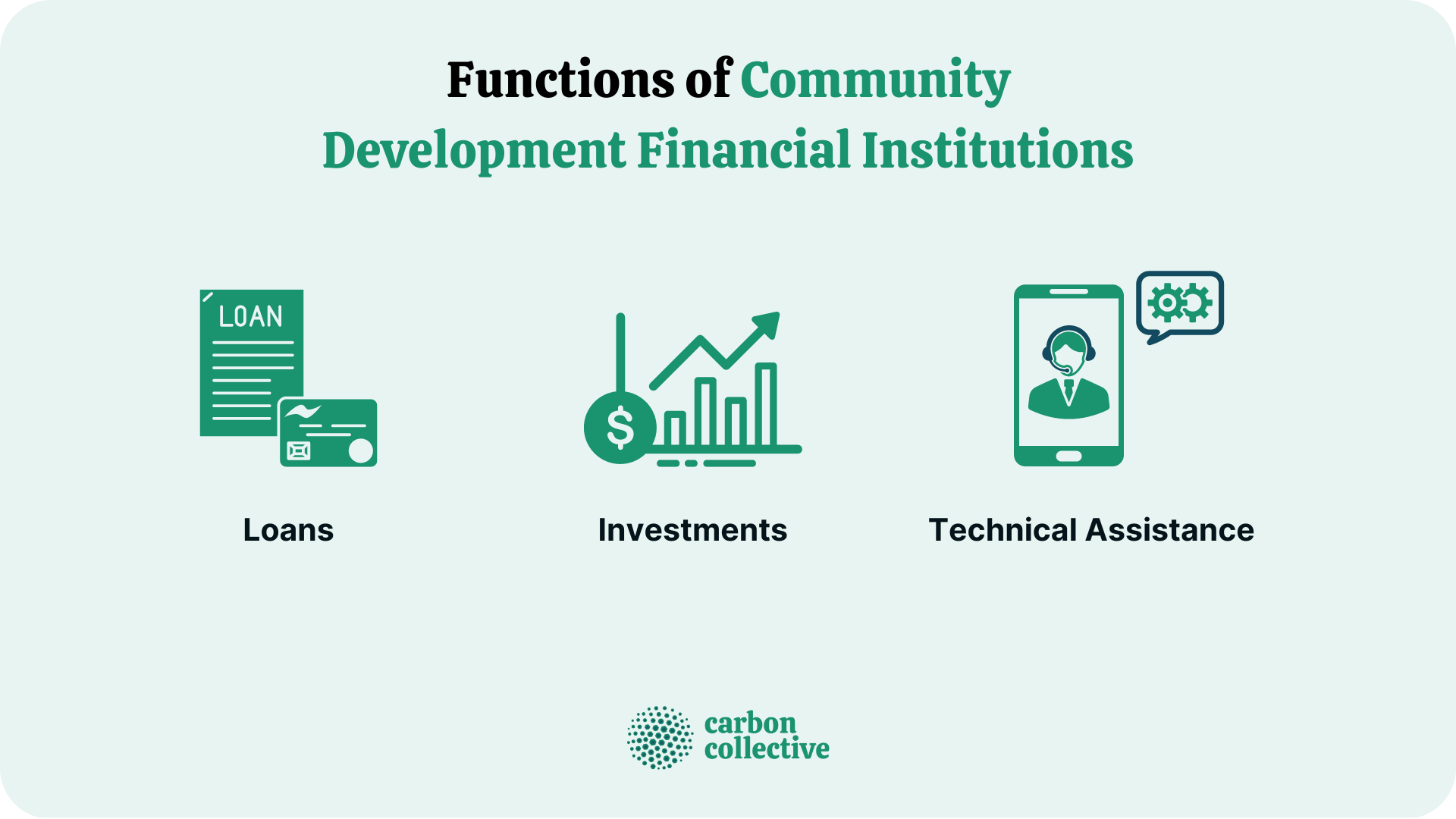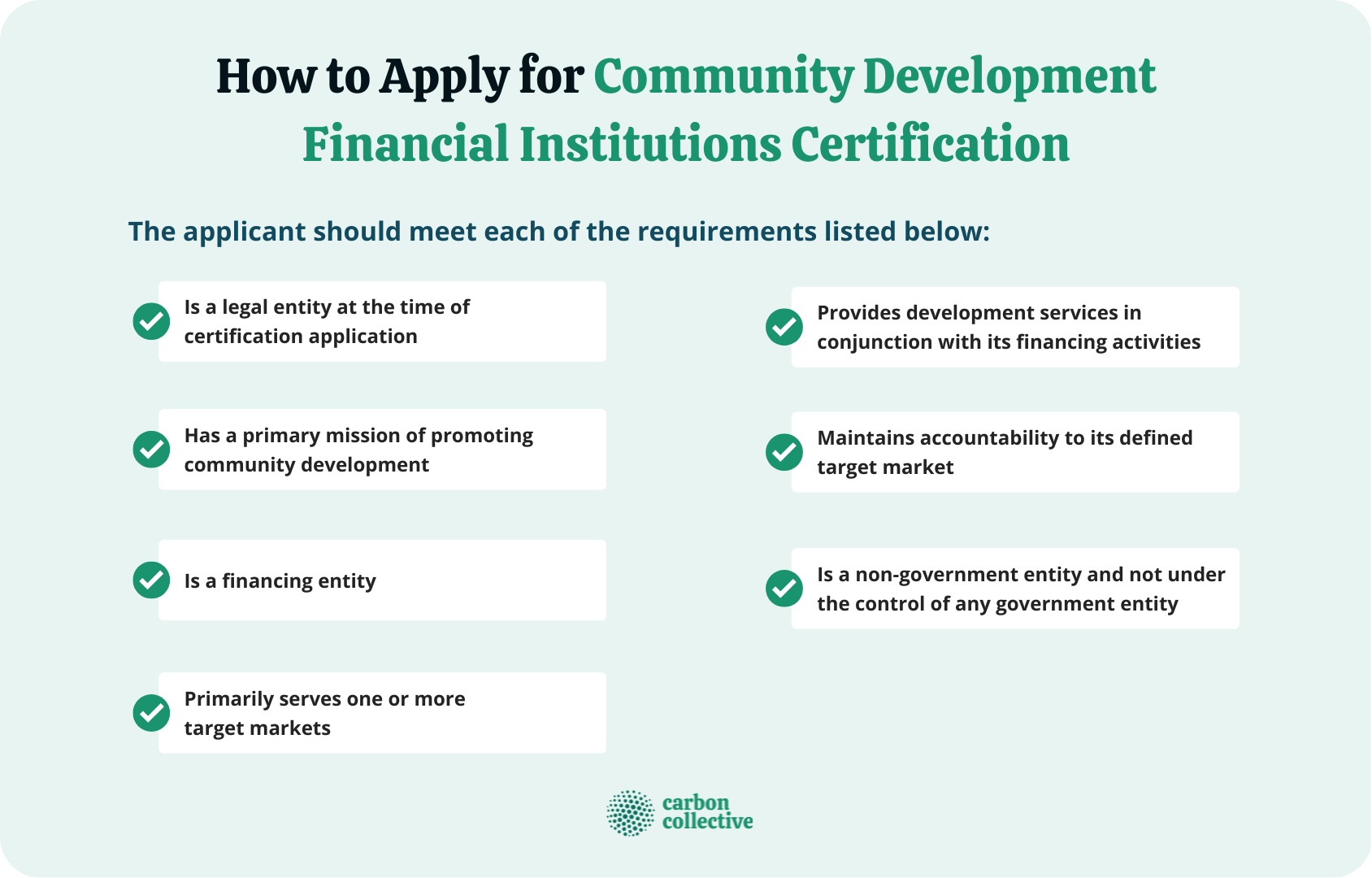Community Development Financial Institutions are private financial institutions that focus on development in low-income communities. They are mission-driven organizations that aim to provide loans, investments, and technical assistance to underserved individuals and communities.
CDFIs receive funding from a variety of sources, including the U.S. Department of the Treasury and private organizations.
CDFIs originated in the 1970s. They are a result of the Community Reinvestment Act of 1977 that addresses the rise of "bank red-lining"—denying people of color access to financial services.
The Act helped ensure that loans went to low-income communities and that the institutions would be viable.
Functions of Community Development Financial Institutions
CDFIs provide investment opportunities to low-income people and communities. They provide financial services such as:
- Loans
CDFIs structure loans for housing, small businesses, or education.
- Investments
CDFIs invest in non-traditional assets, such as affordable housing projects, retail centers, and other community development projects.
- Technical Assistance
CDFIs provide technical assistance to their borrowers through networking opportunities and educational workshops. This helps the borrower use the funds wisely and find the right tools for success.
CDFIs foster economic growth in low-income areas. They work to help people build credit, purchase homes, or start businesses. They also provide funding for local projects that create jobs.
Sectors of the Community Development Financial Institutions Industry

Community Development Banks
Community development banks provide capital through targeted investments, financial services, and affordability strategies to support economic development in low-income communities.
The primary purpose of a community bank is to fund projects in the areas where it operates. Community banks can work with other financial institutions to increase their capabilities by pooling resources and sharing best practices.
These banks are regulated by institutions like the Federal Deposit Insurance Corporation (FDIC), the Federal Reserve, and state banking agencies, depending on their charter.
Credit Unions
Credit unions are non-profit financial organizations that serve the mutual interests of their members.
They provide a wide range of products, such as checking accounts, savings accounts, and loans, at rates often lower than traditional banks can offer.
The National Credit Union Administration (NCUA) is the federal regulator for credit unions in the U.S. It ensures that they follow best practices and maintain adequate reserve requirements, known as "capitalization ratios”.
Loan Funds
Loans funds focus on investing capital in economically distressed areas to help start or expand small businesses and community facilities. Their primary goal is job creation through business expansion and growth.
These organizations are typically managed by boards of directors that represent different communities or neighborhoods with economic development needs.
Loan funds receive funding from corporations, foundations, government agencies, banks, credit unions, endowments donated by individuals, and other private or public donors.
Venture Capital Funds
While venture capital funds are part of the broader CDFI industry, they also present unique challenges. These funds provide equity to small businesses that cannot find funding through traditional avenues due to high risk or lack of collateral.
This type of financially risky investment is made with the belief that these companies will succeed and continue to reinvest profits into the community.
How to Apply for Community Development Financial Institutions Certification
A financial institution must first submit an application to the CDFI Fund to receive certification. According to the U.S. Department of the Treasury Community Development Financial Institutions Fund, the applicant should meet a certain number of requirements.
The Federal Government’s Role in CDFIs
Stimulating economic growth, especially in the country's most distressed communities, is one of the primary functions that CDFIs serve.
Financial institutions first need to complete an application to receive federal funding from the U.S. Department of the Treasury.
Once they have been certified, their primary goal in operation should be to respond to low-income communities’ credit needs. Hence, they are expected to offer flexible financial services.
The federal government supports these certified financial institutions through providing funds and tax credits backed by the U.S. Department of the Treasury's CDFI Fund.
A variety of programs, ranging from mortgage lending to first-time homebuyers to commercial loans for businesses, are available through the CDFI Fund.
There are also federal funds available for groups seeking financing for community revitalization projects through community development financial institutions.
These organizations use private capital and public resources to help finance projects that improve local quality of life through better housing, employment opportunities, improved energy efficiency standards, and other benefits.
Final Thoughts
Many people believe CDFIs may duplicate efforts already made by traditional financial institutions or government programs with similar goals.
However, what makes these organizations unique is their commitment to understanding local needs in order to offer the most effective solutions for growth in the community.
As traditional banking institutions have grown and become more complicated, CDFIs have continued to focus on offering personalized service that helps empower communities through economic development.
FAQs
1. What are Community Development Financial Institutions (CDFIs)?
Community Development Financial Institutions provide flexible financial services to low-income areas so they can reach their full potential. These organizations serve as a bridge between private investors or philanthropy groups who want to support disadvantaged communities with capital.
2. What is bank red-lining?
Red-lining involves a financial institution drawing a red line on a map around certain low-income areas. This line indicates the districts where the institution will not issue loans. They do this because they believe that if they issue a loan in these areas, there is a high chance of default, and they will lose out on the money.
3. How do CDFIs help against red-lining?
CDFIs work to serve disenfranchised communities by offering the same types of financial services that may be available elsewhere but tailoring them to meet the unique needs of their community. CDFIs also offer training and build capacity within these disadvantaged communities to help them evolve and become more self-sufficient through access to jobs and affordable housing options.
4. How is community development achieved by CDFI funding?
CDFIs help rebuild communities through job creation, affordable housing options, and improved access to healthcare and education. Since they work with local governments and community members to set up initiatives focused on change, these organizations strengthen the cities they serve by providing an economic boost that will increase revenue for business owners and improve the quality of life for citizens.
5. Which banks in the country are CDFIs?
There are several banks in the United States that have been approved as Certified Community Development Financial Institutions. To know which banks may be available in your area, visit the CDFI Fund website.


